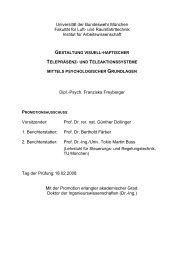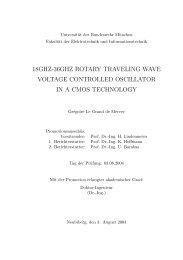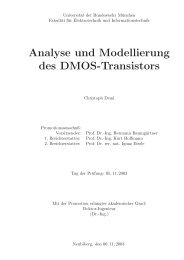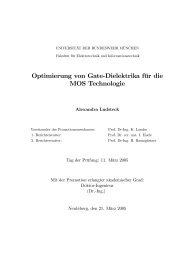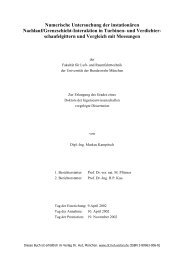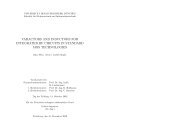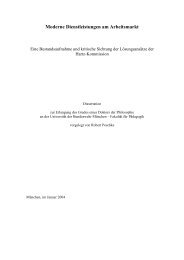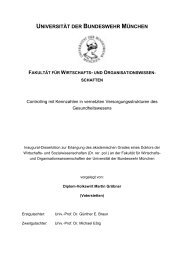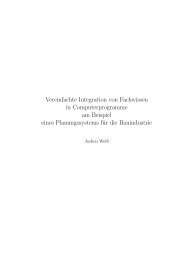Precise Orbit Determination of Global Navigation Satellite System of ...
Precise Orbit Determination of Global Navigation Satellite System of ...
Precise Orbit Determination of Global Navigation Satellite System of ...
You also want an ePaper? Increase the reach of your titles
YUMPU automatically turns print PDFs into web optimized ePapers that Google loves.
Chapter 6 Algorithms <strong>of</strong> <strong>Orbit</strong> <strong>Determination</strong> <strong>of</strong> IGSO, GEO and MEO <strong>Satellite</strong>s<br />
ϖ ϖ ∂O<br />
ϖ ∂O<br />
ϖ 1 ∂ O ϖ 2 1 ∂ O ϖ 2<br />
yk<br />
= y′<br />
k + ( ) ′ ∆xk<br />
+ ( ) ′ ∆z<br />
k + ( ) ′ ( ∆x<br />
) + ( ) ′ ( ∆ ) + ...<br />
2 2 k<br />
z<br />
2 2 k<br />
∂x<br />
∂z<br />
∂x<br />
∂z<br />
where „ ´ “ means related terms are computed by approximate ρ xk ′ at epoch tk .<br />
Neglecting the second and higher order terms and supposing<br />
∂f<br />
∂O<br />
�<br />
Fk<br />
= ( ) ′ k, Hk<br />
= ( ) ′ k �<br />
∂x<br />
∂x<br />
�<br />
ϖ ϖ ϖ ϖ ϖ ϖ<br />
∆xk′= xk − xk′ , ∆z<br />
= zk − zk′<br />
�<br />
�<br />
the linear dynamic and observation equations can be expressed as<br />
ϖ<br />
∆&x ϖ ϖ<br />
′= ∆ ′+ �<br />
k Fk xk wk<br />
�<br />
ϖ ϖ ϖ ϖ �<br />
yk = Hk∆xk + Gk∆zk + ε k��<br />
2<br />
72<br />
2<br />
(6-40)<br />
(6-41)<br />
(6-42)<br />
where ρ wk is the dynamic noise and ρ ε is the measurement noise and we can further assume that<br />
ϖ ϖ<br />
Ew ( ) = 0, E(<br />
ε ) = 0.<br />
k k<br />
The satellite dynamic system equation becomes<br />
ϖ ϖ ϖ<br />
∆x = Φ ∆x + Γ w<br />
k k, k−1 k−1 k, k−1 k−1<br />
(6-43)<br />
where Φ kk , −1 is a solution <strong>of</strong> following differential equation<br />
dΦ<br />
dt<br />
= FΦ<br />
(6-44)<br />
Eq.(6-44) shows that if the dimension <strong>of</strong> state vector is 6, actually 36 differential equations in Eq.(6-44) must be<br />
solved. In the orbit computation, the dimension <strong>of</strong> state vector is more than 6, so the solution <strong>of</strong> Eq.(6-44) is a<br />
time-consuming task for computer. Eq.(6-44) can only be rigorously solved using numerical integration method.<br />
For actually application, some approximation approach may be used. From Kalman filter algorithm, ϖ xk ′ should<br />
be first computed using numerical integration, ϖ xk ′ is also called reference value (or ϖ ϖ Λ ϖ<br />
x0′ , x1′ , , xk′ series called<br />
reference orbit) and should be precisely computed, as the errors <strong>of</strong> the reference orbit will affect the accuracy <strong>of</strong><br />
orbit determination; for computation <strong>of</strong> ∆ ϖ x k and Pkk-1, Φ kk , −1 may not be so precise as for the computation <strong>of</strong><br />
ϖ<br />
xk ′ . Therefore approximation approach can be used to compute Φ kk , −1 for ∆ ϖ x k and Pkk-1. The computation<br />
burden will be significantly reduced and the accuracy <strong>of</strong> orbit determination will be kept.<br />
The approximation approach <strong>of</strong> the solution <strong>of</strong> Eq.(6-44) in the stationary system can be expressed as<br />
Φ( t) e Ft<br />
= (6-45)<br />
Supposing t=h, Φ is a system transition matrix, then according to Tarlor series<br />
Fh<br />
1 1<br />
Φ( h) = e = I + Fh+ Fh* Fh+ Fh* Fh* Fh+<br />
....<br />
2!<br />
3!<br />
where<br />
I an identity matrix.<br />
Referring to Eq.(6-11) to Eq.(6-13), F in Eq.(6-46) may be written as<br />
(6-46)



